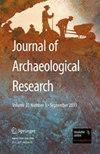Urbanization in Iron Age Europe: Trajectories, Patterns, and Social Dynamics
IF 4.1
1区 历史学
Q1 ANTHROPOLOGY
引用次数: 0
Abstract
The development of the first urban centers is one of the most fundamental phenomena in the history of temperate Europe. New research demonstrates that the earliest cities developed north of the Alps between the sixth and fifth centuries BC as a consequence of processes of demographic growth, hierarchization, and centralization that have their roots in the immediately preceding period. However, this was an ephemeral urban phenomenon, which was followed by a period of crisis characterized by the abandonment of major centers and the return to more decentralized settlement patterns. A new trend toward urbanization occurred in the third and second centuries BC with the appearance of supra-local sanctuaries, open agglomerations, and finally the fortified oppida. Late Iron Age settlement patterns and urban trajectories were much more complex than traditionally thought and included manifold interrelations between open and fortified sites. Political and religious aspects played a key role in the development of central places, and in many cases the oppida were established on locations that already had a sacred character as places for rituals and assemblies. The Roman conquest largely brought to an end Iron Age urbanization processes, but with heterogeneous results of both abandonment and disruption and also continuity and integration.铁器时代欧洲的城市化:轨迹、模式和社会动态
最早的城市中心的发展是温带欧洲历史上最基本的现象之一。新的研究表明,阿尔卑斯山以北最早的城市是在公元前六世纪到公元前五世纪之间发展起来的,这是人口增长、等级化和中央集权进程的结果,其根源在于前一时期。然而,这只是一个短暂的城市现象,随后出现了一个危机时期,其特点是主要中心被放弃,回归到更加分散的居住模式。公元前三世纪和公元前二世纪出现了新的城市化趋势,出现了超地方性的圣地、开放式聚落,最后是坚固的oppida。铁器时代晚期的聚落模式和城市轨迹比传统观点认为的要复杂得多,包括开放式遗址和防御工事遗址之间多方面的相互关系。政治和宗教因素在中心地带的发展中起着关键作用,在许多情况下,oppida 是建立在作为仪式和集会场所已经具有神圣性质的地方。罗马人的征服在很大程度上结束了铁器时代的城市化进程,但也带来了不同的结果,既有废弃和破坏,也有延续和融合。
本文章由计算机程序翻译,如有差异,请以英文原文为准。
求助全文
约1分钟内获得全文
求助全文
来源期刊

Journal of Archaeological Research
Multiple-
CiteScore
10.20
自引率
7.90%
发文量
9
期刊介绍:
Journal of Archaeological Research publishes the most recent international research summaries on a broad range of topics and geographical areas. The articles are intended to present the current state-of-the-discipline in regard to a particular geographic area or specific research topic or theme. This authoritative review journal improves access to the growing body of information and literature through the publication of original critical articles, each in a 25-40 page format.2-Year Impact Factor: 4.056 (2017) 5-Year Impact Factor: 4.512 (2017)2 out of 85 on the Anthropology listIncluded in the European Reference Index for the Humanities (ERIH) PLUS The European Reference Index for the Humanities and the Social Sciences (ERIH PLUS) was created and developed by European researchers under the coordination of the Standing Committee for the Humanities (SCH) of the European Science Foundation (ESF). https://dbh.nsd.uib.no/publiseringskanaler/erihplus/about/indexSCImago Journal and Country Rank (SJR) 2018: 1.7102 out of 263 on the Archeology (Arts and Humanities) list3 out of 254 on the Archeology list2 out of 131 on the General Arts and Humanities listSJR is a measure of the journal’s relative impact in its field, based on its number of citations and number of articles per publication year.Source Normalised Impact per Paper (SNIP) 2018: 2.112The SNIP measures contextual citation impact by weighting citations based on the total number of citations in a subject field. The impact of a single citation is given higher value in subject areas where citations are less likely, and vice versa.CiteScore 2018: 3.86Rated ''A'' in the Australian Research Council Humanities and Creative Arts Journal List. For more information, visit: http://www.arc.gov.au/era/journal_list.htm
SCImago Journal and Country Rank (SJR) 2011 1.227 Archeology 1 out of 96 Archeology (Arts and Humanities) 1 out of 59 Arts and Humanities (miscellaneous) 1 out of 243
 求助内容:
求助内容: 应助结果提醒方式:
应助结果提醒方式:


